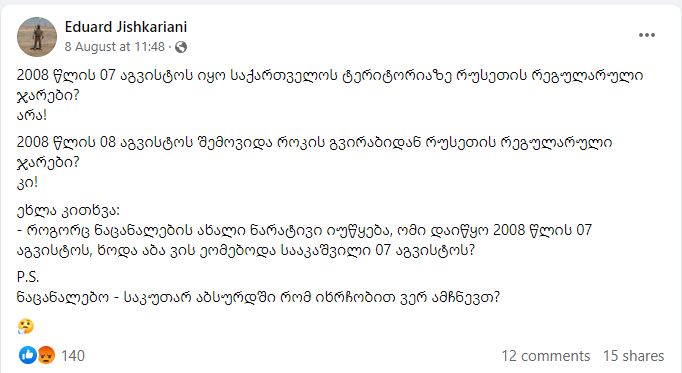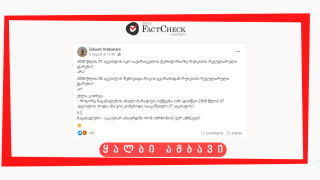The Eduard Jishkariani Facebook account, whose pieces of disinformation have been verified by FactCheck multiple times in the past (1, 2, 3) disseminated another piece of disinformation. According to his claim, Russian forces entered Georgian territory on 8 August and not 7 August. Therefore, the war started on 8 August according to this claim.

This claim is false which is proven by various official documents as well as international assessments. The Conclusion of the Temporary Parliamentary Commission on Investigation of the Military Aggression and Other Actions of Russia Undertaken Against the Territorial Integrity of Georgia says: “On 7 August, from approximately 00:00, artillery shelling of the villages of Eredvi, Frisi and Vanati became more intense. Simultaneously, the attack on the Sarabuki heights commenced and three Georgian peacekeepers were wounded as a result.”
A recording of a phone conversation obtained by the Ministry of Internal Affairs of Georgia, confirmed the information about the mass entry of the Russian regular army into the territory of Georgia at 03:30. The records show that 20 hours before the retaliatory action of the Georgian military forces, the armed forces of the Russian Federation occupied the Roki tunnel and entered the territory of South Ossetia. The telephone conversation took place between someone named Gasiyev and the commander of the Border Defence Agency and concerns the movement of Russian troops in the direction of the Tskhinvali region. The conclusion also mentions the fact that the authenticity of the records was confirmed by relevant official bodies of the USA.
Of note is that the New York Times published an article, entitled “Georgia Offers Fresh Evidence on War’s start,” on 15 September 2008. The article reads: “The intercepted calls, which senior American officials have reviewed and described as credible if not conclusive, suggest there were Russian military movements earlier than had previously been acknowledged, whether routine or hostile, into Georgian territory as tensions accelerated toward war. Of note is that Ossetian border guards held those phone conversations with the network of a Georgian private cell-phone company.”
The article also underlines that the recordings do not explicitly describe the quantity of armour or indicate that Russian forces were engaged in fighting at that time. The article reads that the Russian side does not deny the authenticity of these recordings. Gen. Lt. Nikolai Uvarov of Russia, who served as a Defence Ministry spokesman during the war, told the New York Times that military hardware regularly moved in and out of South Ossetia, supplying the Russian peacekeeping contingent there.
The materials of Volume III of the Independent International Fact-Finding Mission on the Conflict in Georgia (the so-called Tagliavini Commission) which were provided by the Georgian side, read: “At 03:25, the Ministry of Internal Affairs of Georgia obtained the first communication intercept according to which a Russian military unit that included tanks and military truck loaded with soldiers entered the Roki tunnel.
At 03:41, a large number of armoured vehicles, tanks and military trucks of the Russian regular army streamed into the Roki tunnel and deployed in the Java district as confirmed by two mobile telephone conversations intercepted by the Ministry of Internal Affairs of Georgia. Numerous articles in the Russian press also confirm that Russian army units, namely parts of the 693rd and 135th motor rifle regimens of the 58th army, had entered South Ossetia prior to 8 August. As reported by the South Ossetian de facto regime’s main newspaper, Iuznaia Ossetia, on that night the head of the South Ossetian proxy authorities, Eduard Kokoity, travelled from Tskhinvali to the Java district in order to meet with representatives of the Russian Ministry of Defence).”
The Tagliavini Commission confirms that the so-called volunteers and mercenaries, as well as the military units of the Russian regular army, have been entering the territory of Georgia from Russia since the beginning of August. This is described in the first volume of the commission's report where the fact-finding mission’s outcomes are outlined: “Additionally, there seems to have been an influx of volunteers or mercenaries from the territory of the Russian Federation to South Ossetia through the Roki tunnel and over the Caucasus range in early August as well as the presence of some Russian forces in South Ossetia, other than the Russian JPKF battalion, prior to 14:30 on 8 August 2008.”
The Tagliavini report makes emphasis on 14:30 on 8 August 2008 since it was the time Russia started to attack Georgia based on information provided by the Russians themselves: “According to the Russian information provided to the Mission, the first Russian units entered the territory of South Ossetia and Russian air force and artillery began their attacks on Georgian targets at 14:30 on 8 August; that is, immediately after the decision for an intervention was made by the leadership of the Russian Federation.”
The report also says: “The Mission is not in a position to consider as sufficiently substantiated the Georgian claim concerning a large-scale Russian military incursion into South Ossetia before 8 August 2008.” As we see, despite the pressure from the Russian propaganda machine, the Tagliavini Commission has never doubted the fact of the entrance of Russian military units to Georgia prior to 8 August.
In addition, the Commission’s report also highlights that “there are a number of reports and publications, including of Russian origin, indicating the provision by the Russian side of training and military equipment to South Ossetian and Abkhaz forces prior to the August 2008 conflict.” Therefore, the Tagliavini Commission’s report also proves that the so-called Russian peacekeepers were abusing their peacekeeping mandate [1] much earlier that the August war when they supplied weapons to the so-called South Ossetian and Abkhazian forces.
Therefore, the claim that the Russian regular army did not enter Georgian territory on 7 August 2008 is false.
1] Officially, the Commonwealth of Independent States (CIS) Peacekeeping Force (CISPK) of 3,000 Russian troops was created to monitor the implementation of the Moscow Agreement of May 1994. Two months later, at Moscow's request, the mission received a UN mandate. The United Nations Monitoring Mission (UNOMIG), which was deployed in Georgia in August 1993, was tasked with monitoring the operation. The Moscow Agreement defined the operation protocol of the mission which specified the objectives of the CIS/Russian peacekeeping force:
• Observance and support of the ceasefire agreement.
• Facilitating the safe return of refugees and internally displaced persons.
• Supervision of contract execution.
--------------------------------------------------------------------------------------------------------------------------
This article was produced as part of Facebook’s Fact-checking Programme. Given the rating, Facebook may impose different restrictions – click here for full information. For information on issuing a correction or to dispute a rating, please see here.







